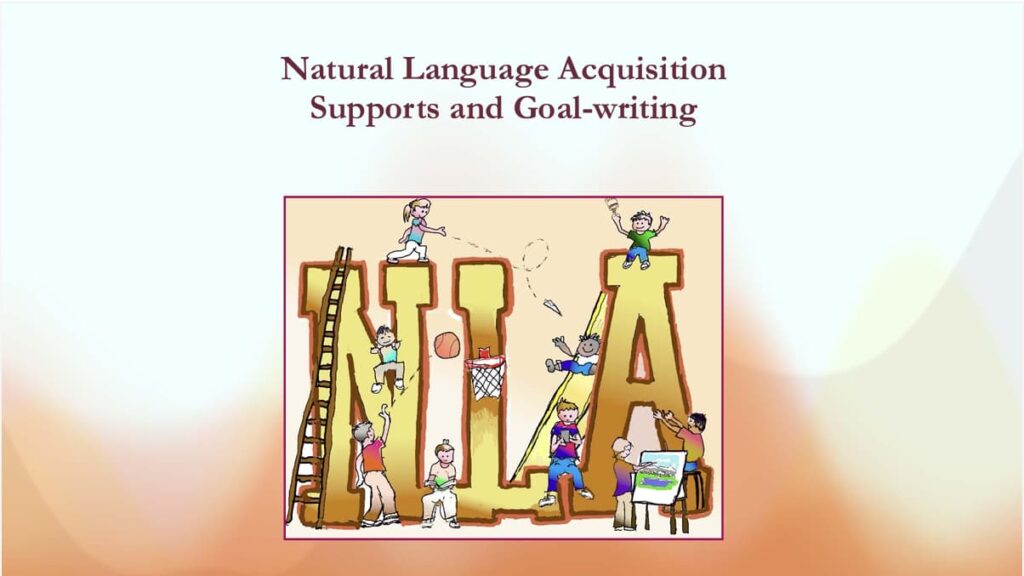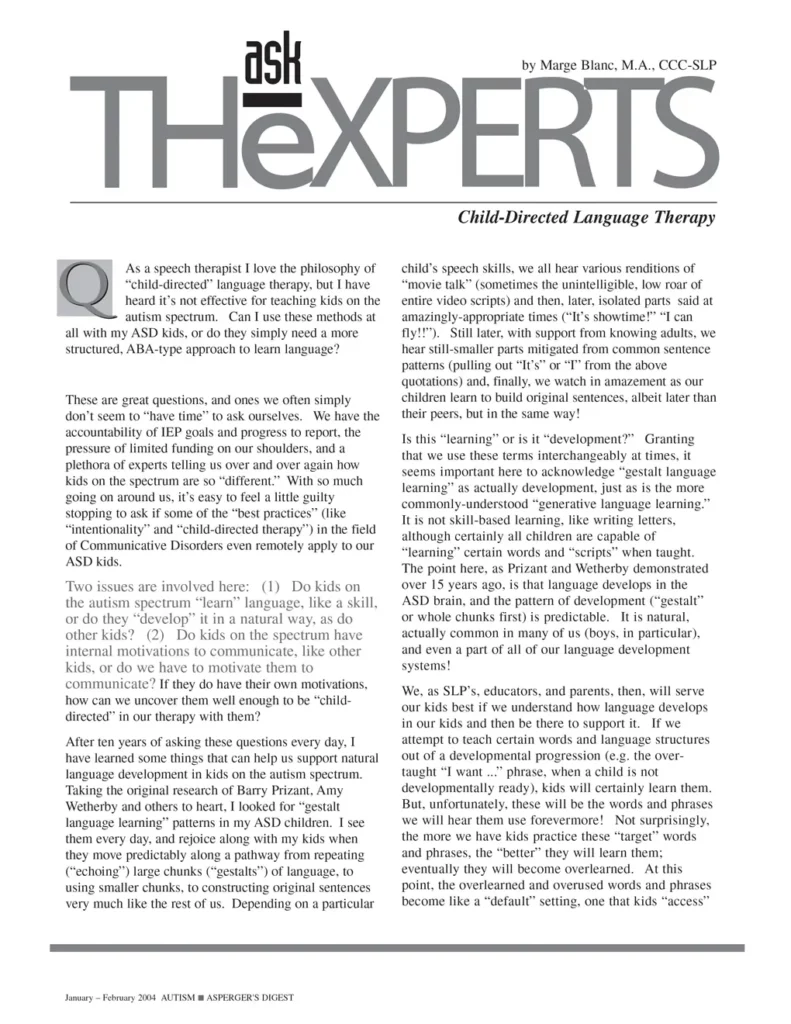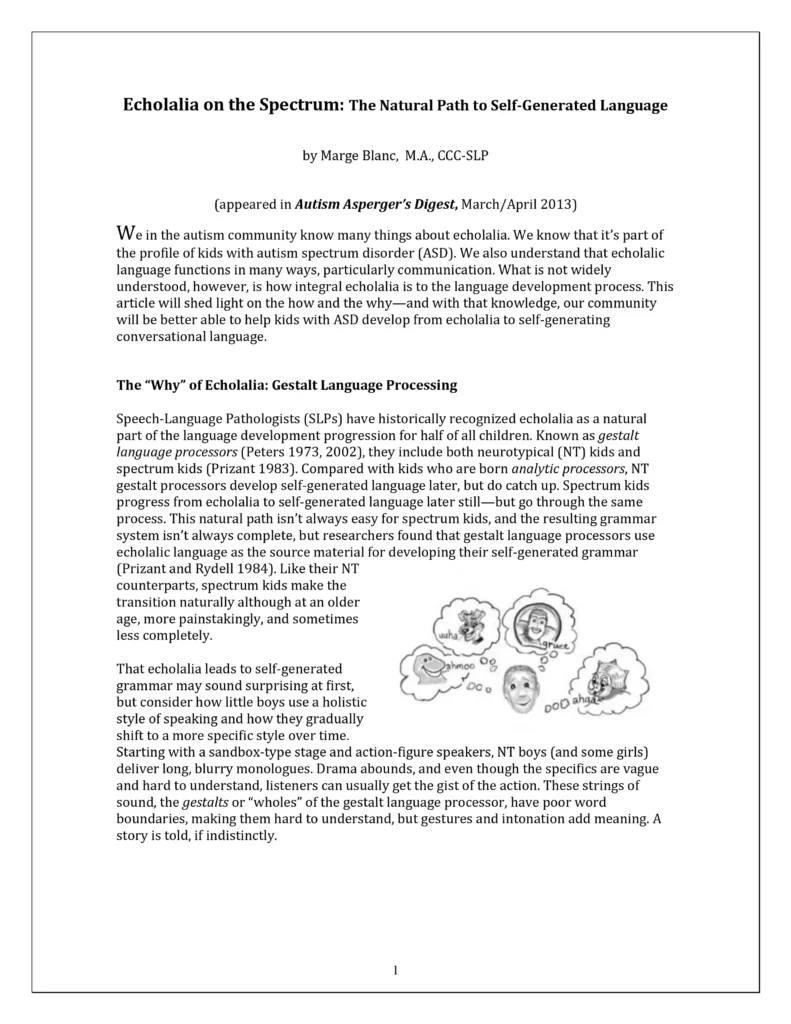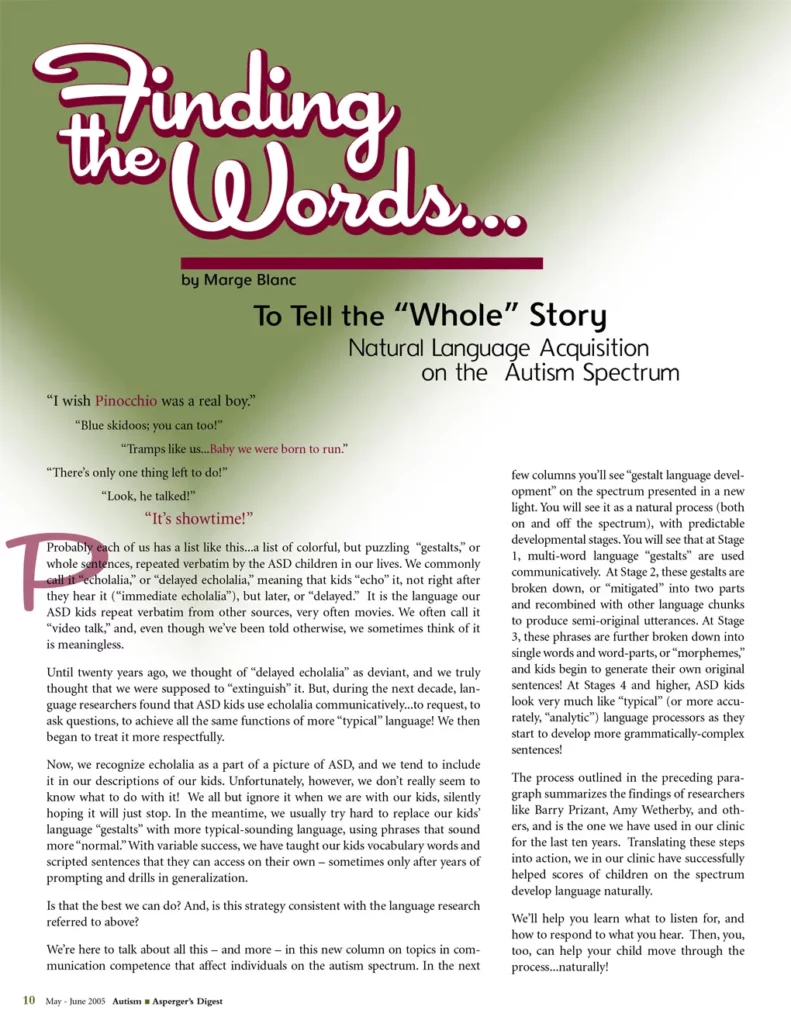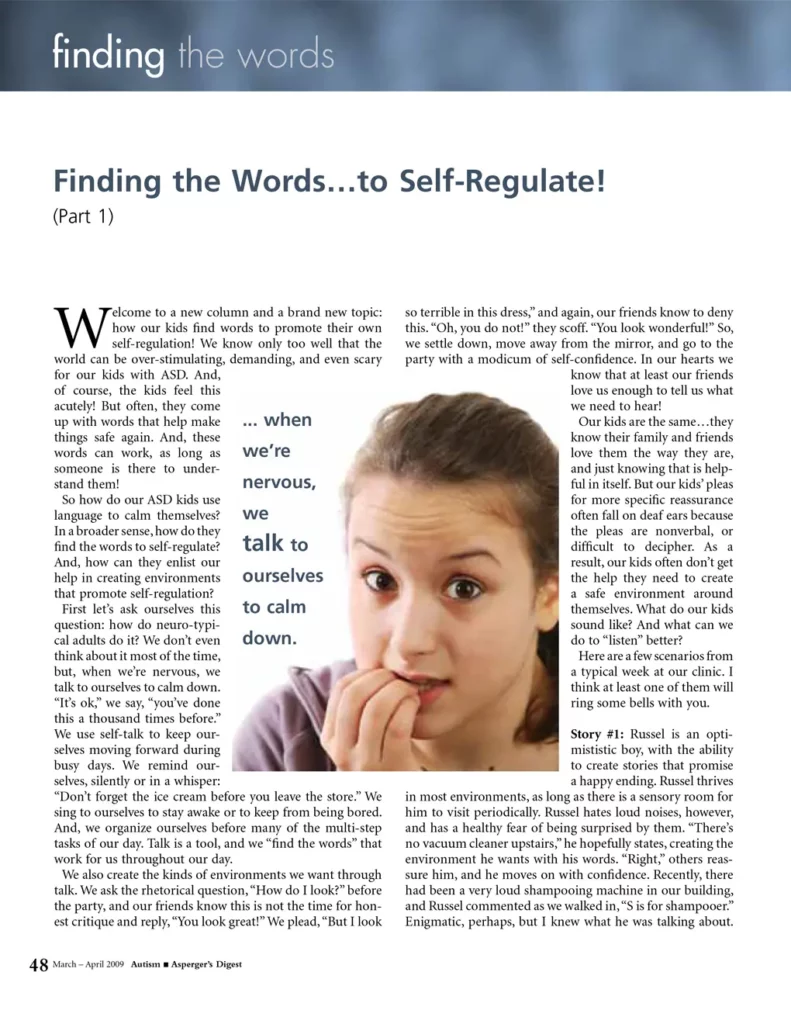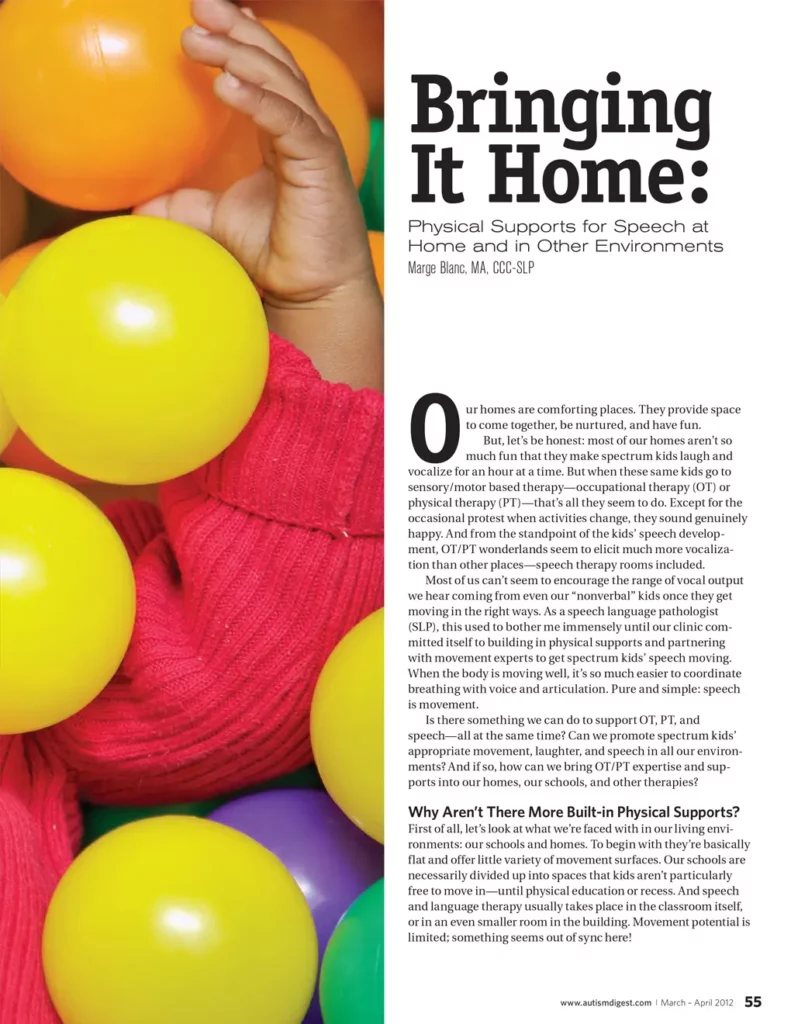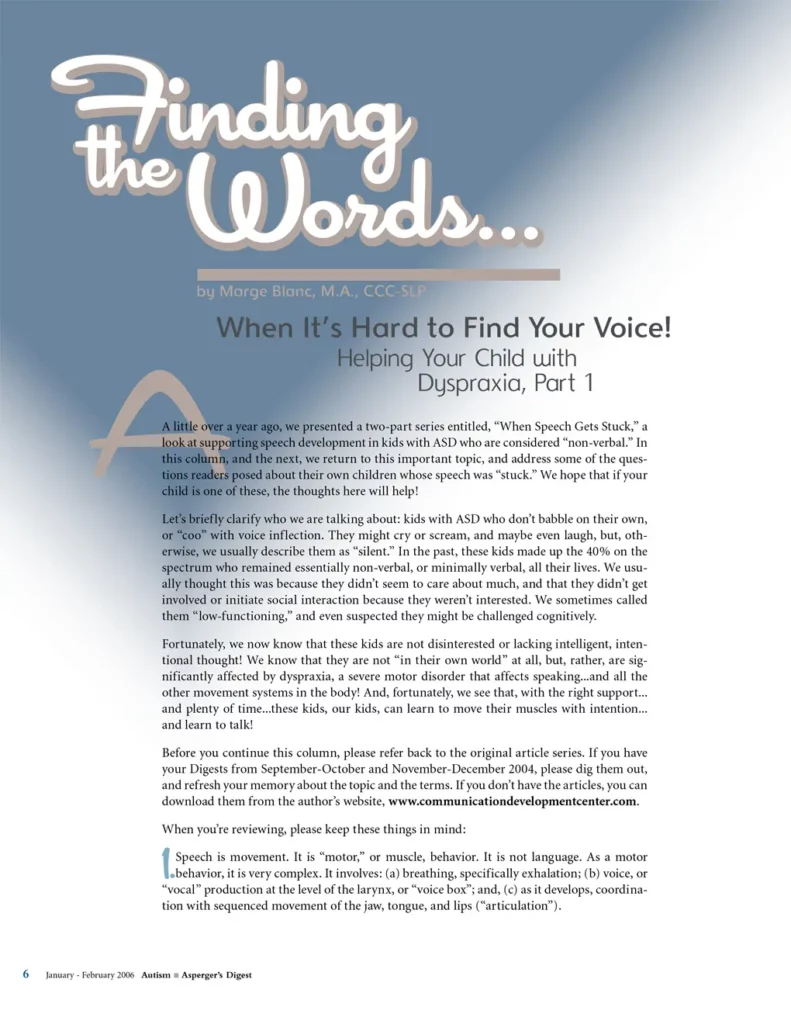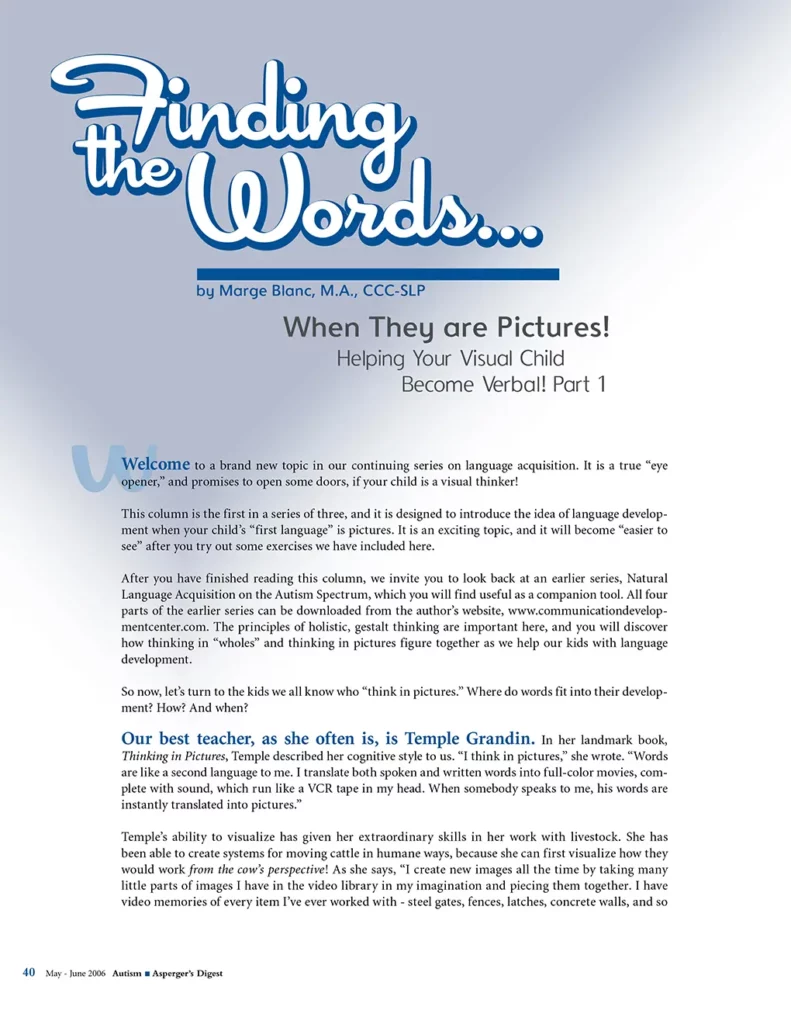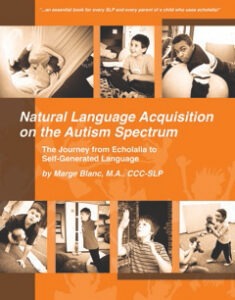NLA Overview
Welcome! Your journey starts here!
The NLA Overview: Webinar #1
Just get started!
Nellie Flynn and Melana Paternoster, two experienced NLA SLPs, show you 90 minutes of their clinical life — to give you “a solid foundation to get started” with NLA!
By the numbers:
FOUR — within 4 minutes you’ll see real examples of language gestalts!
TWENTY FIVE — within 25 minutes you’ll see dozens of examples!
SIXTY — within 60 minutes you’ll lose track of the number of examples — because there are so many!
NINETY — within 90 minutes you’ll see what to do.
Overview Webinar #1
Overview Webinar #2
Webinar #3 Supporting Stages 4-6
Overview Webinar #4: Exploring AAC for GLPs, Part 1
Webinar #5: Older Students
Gestalt Language Development and Speech Development
Now you have an overview of gestalt language development, and know some of the important concepts that help support it. One of the topics that deserves very special attention is the lack of speech intelligibility that is common among young Stage 1 GLPs. With special thanks to Amanda Blackwell and Paulina Elias of Natural Communication, this section of their professional and parent course has been given to us! We are so appreciative!
“Most little kids at Stage 1 are mostly unintelligible.” — (M. Blanc, 2023
As we explore how to support language development in relationship to speech development, we have to know what we can expect. After only one hour, you will know!
Here’s what you can do first:
1. Acknowledge how you know your child is a gestalt language processor.
Maybe you know because of the scripts your child accesses so well, and says so often, maybe to the exclusion of anything else!
But maybe you don’t understand much of anything your child says. You know they love music, and their singing is their best self-expression, maybe to the exclusion of anything else!
Maybe your child doesn’t vocalize much at all, except for an ungraded ‘Uh!!’ here and there — but they do pick the same song over and over to listen to, and the same YouTube clips over and over to watch, maybe to the exclusion of anything else!
But maybe you have no idea the gestalts your chid likes— because your child was taught and prompted to say some things that became over-learned (“I want…” for instance). The scripted language they used to use when they were younger has long-disappeared. You have no idea if they still remember it.
But maybe it’s not really any of these things. You trusted someone else to help your child develop language in the word + word fashion of analytic processors, and it just didn’t work! Maybe they learned a litany of labels, but never got beyond single words. Now you realize those labels are ‘stuck single word gestalts.’ It all happened before you knew about NLA, and your Stage 1 child did the only thing they could do. They learned all those single words as gestalts. Fast forward to now: you have no idea if your child has any useful natural language gestalts in their head. But you are ready to find out!
2. Take a language inventory
A trusting relationship forms the foundation of everything you and your child do from now on. You learned that early in our journey together, and you know you and your child have one! Any time you doubt its strength, you know you will go back and strengthen it!
Within that trusting relationship, you will be able to observe your child, and inventory their play, their interests — and the language your child already has. You don’t need to ‘do’ anything more until you know where your child already is!
How? First, consider this: your GLP has already acquired some language gestalts! Even if you don’t know what they are, they are there, in your child’s head. Whether they can say or sing them or not, your child already has memories — and those memories include a sound track. It may not be clear, but it’s most likely melodic. A child as young as 12 months has already been exposed to the rich sound stream of every-day life and media — and they have acquired some gestalts in their heads. We know this because of the extensive qualitative research that formed the foundation of our language development knowledge — and from the myriad stories you will hear in the Supports thread. Your child is no different!
You may not have evidence of any gestalts, however. Your child may not even seem to be attending to the world around them. But the first premise of gestalt processing is that processing is in our heads, with or without tangible evidence. Your child may or may not be intelligibly speaking, may or may not be speaking at all, or may or may not indicate in any discernible way that they are processing that sound stream. You might be lucky enough to hear some humming; you might hear a little singing; you might hear nothing — but now you will notice any time your child is attentive to particular songs, or particular video clips that are accompanied by sound. You may be fortunate enough to see their eyes light up when they hear a particular Peppa Pig scenario or catch the refrain of a favorite song in the background. But even if you are not aware of any of these signs, you will be — once you attune your eyes and ears and brain to what your child pays attention to.
The conversations and stories in this thread and the Supports thread will introduce you to the varieties of Stage 1-6 experiences clinicians, parents, and educators have witnessed. Once you read a story that reminds you of your own story, you will be intrigued. And once you realize how much a particular gestalt means to your child (even if you don’t really know why), you will be hooked. And once you understand why, you will be an official communication partner. Then you will be on your way!
Welcome!
Supports Overview
Supports can be divided into tiers, from most readily achievable to more intentional or sophisticated. Let’s begin:
Our introductory conversation is casual yet profound. As Nellie embarks on setting up her new clinic, she is applying lessons that she learned about gestalt language development — and natural language development in general. Coming from an ABA clinic where she was the outlier and the voice and model of developmental therapy, Nellie explains what she would like to provide. A lot of it has to do with parents, specifically empowering parents to share their own intuition. Marge and Ereeni add their comments about believing in a child’s own process, and Marge outlines the intake procedures in her own clinic.
Please let this be a beginning point for your own thinking!
In the sections to follow, stories and thought-provoking comments will help you support your GLPs as they begin — and continue — their language development journeys at each Stage of NLA.
Since gestalt language development is natural, when ‘all the stars align’ it is well supported and can flourish. But exactly what does that mean? This section of our website is devoted to ways that people who have come before you have supported their GLPs: sometimes at one particular Stage, but often overlapping from one Stage to another, and often at all Stages. The stories here are myriad, varied, and real. That authenticity means that everything here has been tried and found successful. The ‘evidence’ for supporting natural development is that each child is allowed to flourish — and is celebrated all along the way.
Sometimes supports are intentional, but often progress only needs:
1. understanding of the process of natural gestalt language development
2. belief in the child’s innate ability to access that process
3. using a bit more careful language ourselves
Tier 1:
1. Read enough about this natural process to believe in its legitimacy as the way GLPs develop language.
2. Recognize the Stages of gestalt language processing, and take heart in the consistency between the early research and the more recent research.
3. Recognize what gestalt processing looks like in your child — even if gestalts are unintelligible or expressed in ways that do not involve speaking: selecting the same songs over and over again, playing selected parts of YouTube videos, preferring gestalts/wholes of other kinds (whole sets of alphabet letters, whole collections of toys)
4. Believe in natural child development and language development — and know that individuals can develop language systems into their 20s. Know that you have time to support your child’s natural development!
5. If you are ready for a formal Assessment, please read The Scoring Guide, Chapter 19 of the Natural Language Acquisition book, and plan to gather your Spontaneous Language Sample! All the details are included: gathering a language sample, scoring it, and interpreting the score.
Tier 2:
1. Know that narrating your day with ‘kid language’ might be all you need to do to support your GLP child!
2. Protect your child from well-intended, but misguided language practices intended for ALPs — especially those that come with compliance, rewards, or any form of ABA.
3. Avoid questions unless you know your child can answer them without interfering with their language development. Avoid asking questions, as it is a misguided technique for eliciting language. GLPs echo. Even your questions.
4. Eliminate any focus on single words when your child is at Stage 1. They will be processed as ‘unmitigable’ gestalts — and will be there forever. They do not lead to language development because they don’t break down. Remember that Stage 2 follows Stage 1. Prepare your child for it!
5. Once you’re ready, pick some of your language intentionally. Just 50% of the time, and ‘just talk’ the other 50%. Practice some easy sentences, ones that will give your child a good foundation for language development, then try one or more with your child. If they don’t resonate, try another:
- Let’s +
- I’m +
- We’re +
- It’s +
- What’s +
- Look at +
- How about +
- Where’s +
Tier 3:
This is just the beginning. You have incredible adventures ahead, so enjoy this one!
1. Think about why your child is communicating what they are. Know that the first reason (‘intentions’) any child communicates is to share their emotional experiences in the best ways possible to them — but for GLPs, that’s with language that many people don’t understand.
2. Listen deeply for what your child is sharing. These first communicative intentions for all children are probably to share what’s going on inside their minds. We have under-estimated children — particularly autistic children — and thought that they lacked intention, and just wanted rewards, so we taught them to say names, and then to say ‘I want + .’ Now that we are seeing autistic children as capable — capable of natural language development — we would be wise to eliminate all compensatory strategies. They interfere with true language development, undermine it — and are a waste of precious time.
3. Consider the rich experiences inside our children’s minds. These translate into communicative intentions if our children have us as communication partners!
Does your child communicate on these ways?
- asking for comfort, affection, and safety — reassurance
- asking you to enjoy what they enjoy — maybe a special song, or a tickle, or a sound they hear
- expressing emotions like joy, happiness, fear, and confusion.
- suggesting something to do, maybe together
- sharing what they notice around them
- asking you a question they don’t have the words for yet
- sharing a favorite story, song, or something else they liked
Research
This first overview video begins with a comparison of analytic and gestalt language development, and continues with a description of the research and linguistics involved. Two short video clips illustrate gestalt language in very young children.
History of 'Echolalia'
The second overview video describes some of the history behind our misunderstanding of ‘echolalia’ when applied to children — and continues to describe why we can feel comfortable moving from that term to ‘gestalt language.’ All the NLA Stages of gestalt language development are presented briefly, preparing you for addressing each Stage specifically.
Supports
Nellie explores the ‘policies and procedures’ for her new clinic — especially making sure that parents are involved in their children’s language progress. Marge adds that through teaching parents about gestalt language processing, we are empowering parents to understand their primary role in language development!
Here’s Marge’s first article, the one that launched her into ten years of writing regular articles and columns for the Autism-Asperger’s Digest! In it, she asks the question, “Why are autistic children sometimes viewed as lacking the ability and motivation to develop natural language?” Read for yourself the humble beginnings of this Natural Language Acquisition movement!
Please excuse the out-dated language in this and all of these articles.
If I could revise these published articles, I would honor the now-preferred ‘identify first’ language.
We know that autistic children progress from echolalia to self-generated language, using the same process as neurotypical kids. And we know that “…researchers found that gestalt language processors use echolalic language as a source material for developing their self-generated grammar.” This article from 2013 is one of the foundational articles about Natural Language Acquisition. Short and sweet, please share this with your colleagues tomorrow!
Please excuse the out-dated language in this and all of these articles.
If I could revise these published articles, I would honor the now-preferred ‘identify first’ language.
This was the first article written about Natural Language Acquisition and gestalt language development, published in 2005. An excellent article to educate yourself before you have a chance to read the NLA book, it follows the story of Marge’s first autistic client who developed language from echolalia! It explains gestalt language development in enough detail to give anyone confidence to support their gestalt language processor! Marge’s most popular article and highly recommended!
Please excuse the out-dated language in this and all of these articles.
If I could revise these published articles, I would honor the now-preferred ‘identify first’ language.
This is a six-article series from 2010, and a highly recommended gift for the parents of a newly diagnosed autistic child! It introduces gestalt language development in a gentle way that encourages parents to think about their child today after the diagnosis as the same child they were yesterday! It follows with an easy-to-understand explanation of how autistic children develop language naturally! Autistic children achieve grammar, and this article explains, in a step-by-step fashion, exactly how!
Please excuse the out-dated language in this and all of these articles.
If I could revise these published articles, I would honor the now-preferred ‘identify first’ language.
The world can be overstimulating, demanding, and even scary for our kids…How can kids enlist our help in creating environments that promote self-regulation?” This article presents several real stories about how kids use words to help themselves regulate. This article is a perfect introduction to the topics of self-regulation and co-regulation, with the added benefit of real life stories. From 2009, but just as relevant today!
Please excuse the out-dated language in this and all of these articles.
If I could revise these published articles, I would honor the now-preferred ‘identify first’ language.
A short companion article to “Finding the Words…To Self-Regulate” that describes how regulation and language retrieval come together — or don’t — and how to understand that intersection. Less of a ‘how to’ article, and useful as a quick read for someone new to the topic of self-regulation.
Please excuse the out-dated language in this and all of these articles.
If I could revise these published articles, I would honor the now-preferred ‘identify first’ language.
Why do our kids attend sensory motor-based therapy like OT or PT, and manage to laugh and vocalize for an hour? And why is it that they cannot do this at home? This article illustrates and explains how sensorimotor supports can be provided inexpensively in any home environment. Be prepared for making a big difference in your home!
Please excuse the out-dated language in this and all of these articles.
If I could revise these published articles, I would honor the now-preferred ‘identify first’ language.
This is the classic article that explains why speaking is much more than using speech sounds like consonants, and even vowel sounds. Talking begins with breath support, and continues when that breath promotes voice, and then intonation. Our gestalt language processors are ‘musical kids’ who need whole-body support when they are faced with motor planning challenges. This popular article is yours to read and share — right here!
Please excuse the out-dated language in this and all of these articles.
If I could revise these published articles, I would honor the now-preferred ‘identify first’ language.
Marge’s second-most-read article series expands on the article, ‘When Speech Gets Stuck.’ The levels of support for dyspraxic speech access are detailed here so you can use them to support your child at each level. A must read and “must share“ article!
Please excuse the out-dated language in this and all of these articles.
If I could revise these published articles, I would honor the now-preferred ‘identify first’ language.
Language development is one thing, but finding that newly-developed language is something else. That’s language retrieval! To quote from the column: “…a language retrieval challenge is a discrepancy between language competence and language access.” This article helps us support our children as they are developing language — and when they face a retrieval crisis!
Please excuse the out-dated language in this and all of these articles.
If I could revise these published articles, I would honor the now-preferred ‘identify first’ language.
Temple Grandin taught us that many individuals are visual processors first, and language processors second! If that’s your child or student, this article describes ways of supporting their language development while honoring their visual ‘first language.’ Part of Marge’s ‘Finding the Words…’ column series in the Autism Asperger’s Digest, and a great companion article to ‘Finding the Words…To Tell the Whole Story’ (See this in Language), this is a must read article for supporting many of our gestalt language processors.
Please excuse the out-dated language in this and all of these articles.
If I could revise these published articles, I would honor the now-preferred ‘identify first’ language.

